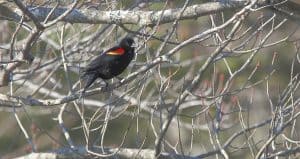
Believe it or not, Spring is coming. We know this by watching and listening to the birds. Year-round residents such as tufted titmice, black-capped chickadees and Northern cardinals have been singing their territorial songs since January, and early migrants are beginning to arrive in Westford.
The first southern migrants to arrive are the red-winged blackbirds. Male red-wings, adult and juvenile males, arrive in February and get an early start setting up their breeding territories in wetlands. But first they need to tank up on suet and seed, replenishing their fat reserves for the demanding breeding season to come. These birds are omnivorous, so can easily take advantage of whatever food source is available: seed, suet, fruit, and insects when available. As early as Feb.16, some Westford residents reported red-winged blackbirds at their feeders, and others will be flocking here in the next few weeks. We will begin to hear the males’ distinctive “Conk-a-ree” territorial song. Female red-wings, large brown-striped birds, arrive a few weeks after the males. Each female chooses the male and the nesting site she prefers.
Northern Massachusetts is the red-wings’ northern limit for winter habitat, so some may actually be year-round residents here. In winter they range as far south as Central America. Some southern and western birds may not migrate at all. In Westford, I typically get no winter or fall reports of red-winged blackbirds at feeders, but start to get reports in February and through August.
Red-winged blackbirds are colonial nesters with small territories that they defend vigorously. One male may defend several nests in the same territory. The glossy black male red-wing sits up high on a cattail or other wetland plant, and flashes his red shoulder patches to catch attention. When not defending territory, he keeps these red epaulets hidden under his wing feathers. Deep cup-shaped nests are woven by the females he has managed to attract. These nests are woven of strips of bark and grasses around and between two upright cattails or reeds, and lined with mud and soft grasses. Nests are camouflaged and placed low near the water, to foil most predators. In March, the female lays 3-6 bluish, spotted eggs. After two to three weeks of brooding by the female, the eggs hatch. At this point, both parents begin a period of intense feeding of the young. In another two weeks, young will fledge and accompany parents to the bird feeder and other good feeding spots.
Watch this month to find male red-winged blackbirds singing atop wetland plants or in trees near wetlands. See if you can find the camouflaged nests and females that he is protecting. The circle of life is beginning again.
Many thanks to all flora and fauna reporters for the month of February. Please send reports by March 26 for inclusion in next month’s column. You can write me at 7A Old Colony Drive, call me at 692-3907, or e-mail me at mariancharman@gmail.com.
Late January Reports:
Ginger Dries, Sherwood Drive. January 29, two deer lay down on our hill all afternoon, just resting. They didn’t follow the rest of the herd of six when it moved through. Eventually the two resting deer got up and went in the same direction as the herd. Lots of cardinals, chickadees, doves, blue jays, titmice, many juncos, two Carolina wrens, and woodpeckers of all kinds. During snowstorm, a bird came to the feeder that I hadn’t seen before [from Ginger’s description, I guessed that it was a female pine grosbeak–very exciting!-MH]
Marian/Bill Harman, Old Colony Drive. January 29, big snowstorm, windy, sixteen degrees. At the feeder: Four American tree sparrows, eight juncos, four white-throated sparrows, two goldfinches, one white-breasted nuthatch, two chickadees, one downy woodpecker, one song sparrow, two blue jays, one titmouse, one cardinal.
February Reports:
Marian/Bill Harman, Old Colony Drive. February 6, fourteen degrees. Mamma and two juvenile deer eating neighbor’s shrubs. Saw my first migrant turkey vulture overhead. February 18-21, Cornell Lab of Ornithology Backyard Bird Count: (greatest number seen at one time) two chickadees, two American tree sparrows, two mourning doves, pair of cardinals (male singing), ten goldfinches, one downy woodpecker, two juncos, four titmice (all singing), two blue jays, one pileated woodpecker, vocalizing loudly and drumming on two hollow trees, house finch (singing), three white-breasted nuthatch, nine Canada geese in loose formation overhead, bald eagle soaring over Keyes Pond, red-bellied woodpecker, brown creeper, two red-winged blackbirds at the feeder–first of the spring! February 25, three cardinals (two males, one female), one fox sparrow (beautiful bird, not common).
Diane Duane, Howard rd. February 8 – 2 pairs of bluebirds, finches, juncos, male red bellied woodpecker, several morning doves, downy woodpecker, blue jay, tufted titmouse at suet & chickadee. Bobcat moving through our yard toward beaver brook on Feb 15th.
Ginger Dries, Sherwood Drive. February 25, a starling on the suet. During the snowstorm, three pairs of cardinals, titmice, chickadees, jays, doves, white-breasted nuthatch, two Carolina wrens, all types of woodpeckers. Saw a fox on the hill in back, and deer passing through. On February 20, 7 a.m. saw a skunk seen passing back and forth on the back hill–never seen during the day before.
Marian Harman is a member of the Westford Conservation Trust, a non-profit conservation organization whose mission is the preservation of Westford’s trails and open spaces. The Trust welcomes new members and volunteers. Check out our website at westfordconservationtrust.org or visit us on Facebook.
